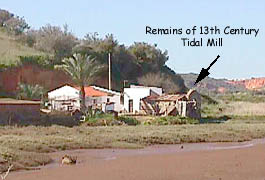

How they used to ...............
Travel - Irrigate - Thresh
- Mill
Process wool - Make Paint - Make Salt
Travel
A leap out of the vehicle, point and shoot, captured this elderly couple in their
carrinho as they were about to disappear over the hill. (It also shows the delight of old
Portuguese public wiring which can occasionally be found!)
A similar occasion found a local farmer going into Espiche to collect water. The Espiche
spring is often quite busy, as the water is considered to be the best natural water in the
area.
Traditional ways of life that are not 'put on for the tourist' are more likely to be
discovered in this "Cornwall" of Portugal.
Vila do Bispo. 11th May 1999 |
Going to Espiche, 29th September 1999 | Donkey cart in Almadena |
Irrigation
Many farms still have their own wells, but with the dryer climate, some have now resorted
to bore-holes. With the advent of the diesel or electric pump, it is now simple to draw
water from the well.
Strange structures over wells, with vertical metal wheels and strange bars, are known as
Noras.
These wheels used to have a chain which looped down into the water. Metal buckets
(originally clay pots) were attached to the chain. With the aid of a donkey, mule or ox,
harnessed to the long pole, walking around and around the well, the water was lifted and
poured into a chute, which led to the aqueduct for irrigating the crops.
By the EN125, Espiche |
Threshing and Drying
An Eira is a circular paved area, where each farmer used to thresh the grain. Now they are
more often used for drying produce such as maize for the animals, pulses, almonds and
figs.
The threshing could be carried out with a flail, or by circling a number of animals -
donkeys, mules, horses and oxen, over the pavement, to separate the kernels from the ears.
These structures are also found in Morrocco, showing the Arabic origin of the method.
| waiting for photo | |
| Abandoned Eira near Lagos | The Eira at Vale Grifo |
Windmills
An ancient method of capturing the force of nature, the remains of windmills are scattered
throughout the hills, and surrounding the villages.
A few have been restored and some converted into homes. Now the modern variety can be seen
where the Atlantic winds prevail, generating electricity for the National Grid
| Almádena Windmill ruin | Restored Mill at Odeaxere |
Converted Mill at Barão S. João |
The Wind Farm behind Vila do Bispo |
A Tidal Mill
Just opposite the aerodrome at Lagos, the remains of a 13th century tidal mill flank a
bend in the River Bensafrim.
 |
Send mail to info@valegrifo.com with questions
or comments about this web site.
Copyright © 1999 Vale Grifo
Last modified: June 04, 2007